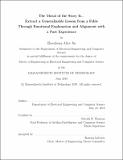| dc.contributor.advisor | Patrick H. Winston. | en_US |
| dc.contributor.author | Jin, Zhaozheng Alice. | en_US |
| dc.contributor.other | Massachusetts Institute of Technology. Department of Electrical Engineering and Computer Science. | en_US |
| dc.date.accessioned | 2019-11-22T00:03:19Z | |
| dc.date.available | 2019-11-22T00:03:19Z | |
| dc.date.copyright | 2019 | en_US |
| dc.date.issued | 2019 | en_US |
| dc.identifier.uri | https://hdl.handle.net/1721.1/123031 | |
| dc.description | This electronic version was submitted by the student author. The certified thesis is available in the Institute Archives and Special Collections. | en_US |
| dc.description | Thesis: M. Eng., Massachusetts Institute of Technology, Department of Electrical Engineering and Computer Science, 2019 | en_US |
| dc.description | Cataloged from student-submitted PDF version of thesis. | en_US |
| dc.description | Includes bibliographical references (pages 65-66). | en_US |
| dc.description.abstract | After reading The Tortoise and the Hare, it may feel instinctive to conclude that the moral of the story is "slow and steady wins the race". However, research has shown that this is not so obvious to children, who tend to focus on story-specific details like napping in the middle of the race. In learning the moral, it is crucial to generalize. Otherwise, we would need a fable for every unique circumstance. What computational process underlies our seemingly intuitive ability to extract a generalizable moral of a story? Fables play integral roles across cultures and societies. From a young age, children are read fables to instill moral values. If we are build an artificial human intelligence system, we must first answer this question. In this thesis, I take a step toward fulfilling my vision by building MAXIM, a new module in the Genesis Story Understanding System. From a fable and a description of a past experience written in English, MAXIM extracts and generalizes the moral of the fable and explains it in English. For example, from Rudolph the Red-Nosed Reindeer and The Math Aficionado, MAXIM concludes It's ok if you are different because Valuable Rudolph is different. Notably, idiosyncrasies of the story, such as having a red nose, are not stated in the moral. MAXIM extracts a generalizable moral by first interpreting both stories on an emotional level. By explaining the emotional states and their transitions, the system can identify the moral challenge. Then, MAXIM aligns the stories by emotional states to abstract away story-specific details. In developing MAXIM, I have distilled four principles for extracting a generalizable moral: Viewpoint Character Principle, Reversal of Fortune Principle, Emotional Explanation Principle, and Emotional Alignment Principle. Though internalized by adults, these principle are learned, perhaps unconsciously, by children. | en_US |
| dc.description.statementofresponsibility | by Zhaozheng Alice Jin. | en_US |
| dc.format.extent | 66 pages | en_US |
| dc.language.iso | eng | en_US |
| dc.publisher | Massachusetts Institute of Technology | en_US |
| dc.rights | MIT theses are protected by copyright. They may be viewed, downloaded, or printed from this source but further reproduction or distribution in any format is prohibited without written permission. | en_US |
| dc.rights.uri | http://dspace.mit.edu/handle/1721.1/7582 | en_US |
| dc.subject | Electrical Engineering and Computer Science. | en_US |
| dc.title | The moral of the story Is... extract a generalizable lesson from a fable through emotional explanation and alignment with a past experience | en_US |
| dc.title.alternative | Extract a generalizable lesson from a fable through emotional explanation and alignment with a past experience | en_US |
| dc.type | Thesis | en_US |
| dc.description.degree | M. Eng. | en_US |
| dc.contributor.department | Massachusetts Institute of Technology. Department of Electrical Engineering and Computer Science | en_US |
| dc.identifier.oclc | 1127649723 | en_US |
| dc.description.collection | M.Eng. Massachusetts Institute of Technology, Department of Electrical Engineering and Computer Science | en_US |
| dspace.imported | 2019-11-22T00:03:19Z | en_US |
| mit.thesis.degree | Master | en_US |
| mit.thesis.department | EECS | en_US |
